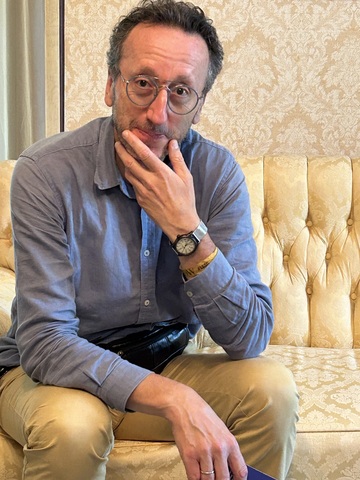
A thoughtful Sevan sitting on his wife's grandmother's preserved settee. Photo © Carol Bergman 2025
Leave the door open for the unknown, the door into the dark. That's where the most important things come from, where you yourself came from, and where you will go.
― Rebecca Solnit, A Field Guide to Getting Lost
On a warm July Thursday, check-in day at Mohonk Mountain House, I sat with Sevan Melikyan away from the crowd in the cool Lake Lounge for an in-depth conversation. He is best known in the Hudson Valley as the founder and curator of the Wired Gallery in High Falls where he mounts shows of local artists. He also organizes pop-up art fêtes at Mohonk Mountain House, offers in-gallery art lectures, and conducts art tours abroad three times a year. He's headed to Istanbul at the end of September, and Sicily, Malta and Provence in 2026. His wife, Maria, a professor of arts management at SUNY Purchase, helps him with one tour a year. For the others, he hires an assistant.
Though New Paltz and environs is a small community with overlapping friendships and artistic circles, I had never met Sevan until a friend's recent photography show at the Wired Gallery. It's a small gallery with a beating heart, fully alive to artists and art-making. Sevan and Maria live upstairs, their kitchen the galley for refreshments during openings.
Sevan's journey to the mid-Hudson Valley was complicated. He was born in Istanbul to an Armenian family whose ancestors had survived the 1915-17 genocide without fleeing into a diaspora, but eventually migrated to Paris when Sevan was 9. His father was an engineer, his mother a homemaker. "They were the best parents anyone could have," Sevan says ruefully. And though they were strict when Sevan expressed a desire to study art—something practical, please—they also passed on the sustaining joys of culture, and the importance of learning the language where we live fluently. Sevan speaks four—Armenian, Turkish, French and English.
"I am thinking of myself as an immigrant again," Sevan reflects, "and how I was shocked by the feeling of being a foreigner in Paris. I never felt that way when I arrived in New York." How would Sevan feel if he arrived today, I wondered. How would my family have felt, and just about every family I know. Perhaps there's some solace in the reminder that unless we are indigenous, or descendants of slaves or indentured workers, everyone else in America is an immigrant, or a descendant of immigrants.
Sevan's eldest sister Sheyda had already arrived in New York and eased Sevan's transition to the New World. Before he left Paris, his father had told him he'd marry a green-eyed girl. A prophecy, or simply a heartfelt wish for his son? Sevan did not specify. Little did he know when he fell in love with the green-eyed Maria that she was a Smiley, a member of the abolitionist Quaker family that built Mohonk Mountain House in the late 19th century, and still own it. Sevan has keys to the mansion, literally and metaphorically. He took me on a guided tour through its history, into private locked rooms with solid old furniture and libraries of leather-bound books. "Many are about gardens," he explains, "and there is an old bible on the top shelf." We were in a room on the ground floor that the family reserves for its gatherings and private conversations.
"Art offers hope in the darkest times," Sevan's Artblazing Tours website assures us. How interesting, I thought, as we meandered up the carpet-covered staircase to a closed-off sitting room on the second floor. The preserved Smiley history inspires this tall, lanky energetic man. He nourishes a dream of preserving art history in Ulster County. "I cannot believe how many talented artists there are here," he says. "I want to create an art museum as a permanent repository of this art for future generations." He's identified a property that is up for sale and hopes to develop his vision one day soon. "It will be hard work. How will I fit it in?" he asks rhetorically. It's not an unusual aspiration for a man whose family has survived war, massacre, displacement and flight. The work of unlocking and re-narrating history—all history—is both necessary and grounding. There is still so much we do not know about ourselves, and one another. What is essential in our pasts, and in our dreams, is often invisible, unless we bring it into the light.